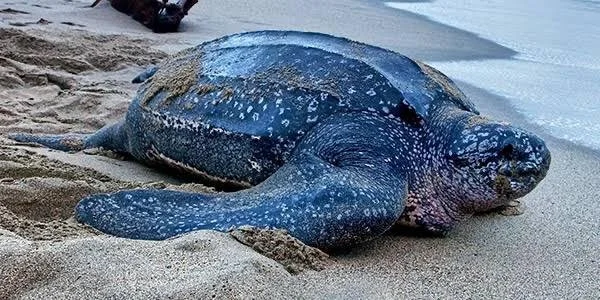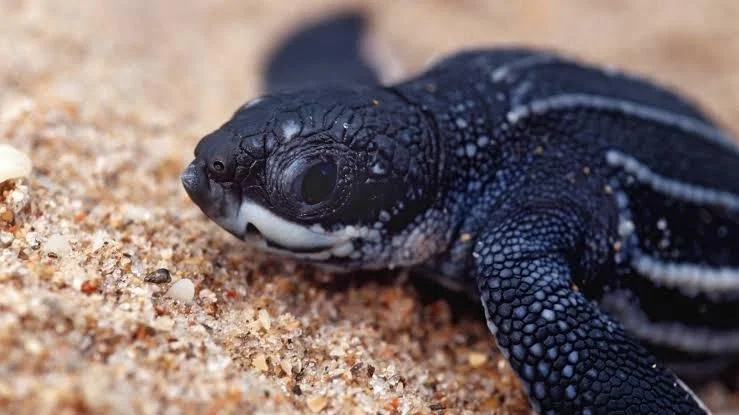Human Influences on the Leatherback Sea Turtle
The Leatherback sea turtle (Dermochelys coriacea) is being forced to adapt and evolve under current changing environmental conditions, influenced by human activity.
This species of turtle is the largest Chelonian and the only living representative of the Dermochelyidae family. Their ancestral roots date back hundreds of millions of years and unlike other sea turtles, they are unique in that they have a soft shell (Chen et al., 2015). The Leatherback is the most widely distributed reptile with sub populations present in the North Atlantic, Pacific and Indian oceans (Troëng et al., 2004).
Fig. 1. Leatherback Sea Turtle (National wildlife Federation, 2021)
The leatherback sea turtle faces a range of transboundary environmental problems which have dramatically impacted its population size, leading to an endangered status with some sub populations being classed as critically endangered (IUCN, 2019). This species feeds predominantly on jellyfish and other gelatinous zooplankton. Subsequently, planktonic plastic is often mistaken as a food source and ingested, getting stuck in the gut and proving fatal. Autopsy reports conducted in 1968 revealed that 37.2% of 371 individuals had consumed large quantities of plastic, contributing to death (Mrosovsky et al., 2009).
As our climate begins to warm, sea ice melts resulting in a rise of global sea levels and a higher frequency of heavy precipitation events, such as storms and hurricanes. This increase in average moisture levels can have devastating effects on nesting sites. Nest sites in wetter sands suffer higher mortality rates, reduced emergence success and reduced hatchling size (Patino-Martinez et al., 2014). The eggs that do manage to hatch successfully, then face another human influence, ecological light pollution. The artificial light can interfere with hatchling orientation and sea-finding behaviour, leading to higher mortality rates (Bourgeois et al., 2008). Increasing human populations and industrial expansion suggest that this problem will only become more prolific.
The sex of sea turtle hatchlings is determined by TSD, temperature-dependent sex determination. Climate change and warmer conditions have led to a ‘highly female-biased sex ratio’, causing concern for the species genetic viability and future biodiversity (Patino-Martinez et al., 2014). A population with a high reproductive skew can result in an increase in inbreeding and therefore the loss of genetic diversity, whilst allowing more subordinate individuals a chance of reproductive success (Heppell et al., 2022).
Fig. 2. Leatherback Turtle hatchling (Universal Images Group, 2020)
To combat some of these issues, leatherback turtles are evolving, particularly with their nesting behaviour. Reports suggest that they begin to nest earlier in the year, when beaches are cooler, giving them a higher chance of level sex ratios (Santidrián Tomill et al., 2009). Furthermore, evidence suggests a reduction in nest-site fidelity. In these new nesting locations, females will have a greater chance at success and give their hatchlings a higher chance of survival (Dutton et al.,1999).
Despite the Leatherbacks rapid evolution regarding nesting behaviour, they continue to face a range of threats. Effective conservation of this highly migratory species requires international cooperation and an extensive understanding and study of habitat. As more surveys are conducted, scientists hope to learn more about this species behaviour and how best to conserve them.
-
Bourgeois , S. et al. (2008) Influence of artificial lights, logs and erosion on leatherback sea turtle hatchling orientation at Pongara National Park, gabon, Biological Conservation. Vol. 142(1). pp. 85-93. Available at: https://www.sciencedirect.com/science/article/abs/pii/S0006320708003704 (Accessed: 03 October 2024).
Chen, I.H., Yang, W. and Meyers, M.A. (2015) Leatherback Sea Turtle Shell: A tough and flexible biological design, Acta Biomaterialia. Vol. 28, pp. 2-12. Available at: https://www.sciencedirect.com/science/article/abs/pii/S1742706115301173 (Accessed: 01 October 2024).
Dutton, P.H. et al. (1999) Global phylogeography of the leatherback turtle (Dermochelys coriacea): Journal of Zoology, Cambridge Core. Vol. 248(3). pp. 397-409. Available at: https://www.cambridge.org/core/journals/journal-of-zoology/article/abs/global-phylogeography-of-the-leatherback-turtle-dermochelys-coriacea/3109715E62400C9BB9B97CE7C1C111F2 (Accessed: 01 October 2024).
Heppell, S.S., Wyneken, J. and Heppell, S.A. (2022) A morphologist, a modeler, and an endocrinologist consider sea turtle sex ratios in a changing climate. some wine was involved, Frontiers. Vol. 10. Available at: https://www.frontiersin.org/journals/ecology-and-evolution/articles/10.3389/fevo.2022.952432/full (Accessed: 03 October 2024).
Mrosovsky, N., Ryan, G.D. and James, M.C. (2009) Leatherback turtles: The menace of plastic, Marine Pollution Bulletin. Vol. 58(2). pp. 287-289. Available at: https://www.sciencedirect.com/science/article/abs/pii/S0025326X08005031 (Accessed: 04 October 2024).
Patino-Martinez, J. et al. (2014) The potential future influence of sea level rise on leatherback turtle nests, Journal of Experimental Marine Biology and Ecology. Vol. 467. pp. 116-123. Available at: https://www.sciencedirect.com/science/article/abs/pii/S0022098114002093 (Accessed: 02 October 2024).
Santidrián Tomillo, P., Suss, J.S., Wallace, B.P. et al., (2009). Influence of emergence success on the annual reproductive output of Leatherback Turtles - marine biology, SpringerLink. Vol. 156, pp. 2021–2031 Available at: https://link.springer.com/article/10.1007/s00227-009-1234-x (Accessed: 03 October 2024).
Tomillo, P.S. et al. (2014) High Beach temperatures increased female-biased primary sex ratios but reduced output of female hatchlings in the leatherback turtle, Biological Conservation. Vol. 176. pp. 71-79. Available at: https://www.sciencedirect.com/science/article/abs/pii/S0006320714001992 (Accessed: 04 October 2024).
Troëng, S., Chacón, D. and Dick, B. (2004) Possible decline in leatherback Turtle Dermochelys coriacea nesting along the coast of Caribbean Central America: Oryx, Cambridge Core. Vol. 38(4). pp. 395-403. Available at: https://www.cambridge.org/core/journals/oryx/article/possible-decline-in-leatherback-turtle-dermochelys-coriacea-nesting-along-the-coast-of-caribbean-central-america/6DC41C4906CB585FD9D558B436685863 (Accessed: 03 October 2024).
World Conservation Union (2019) The IUCN Red List of Threatened Species. Available at: https://www.iucnredlist.org/species/46967827/184748440 (Accessed: 01 October 2024).
-
Figure 1: Meredith, M. 2021. Leatherback Sea Turtle. Image
Figure 2: Conlin, M. 2020. VW Pics Via Getty Images. Image

